WTO概论第一章WTO概论(下)
- 格式:ppt
- 大小:1.42 MB
- 文档页数:50
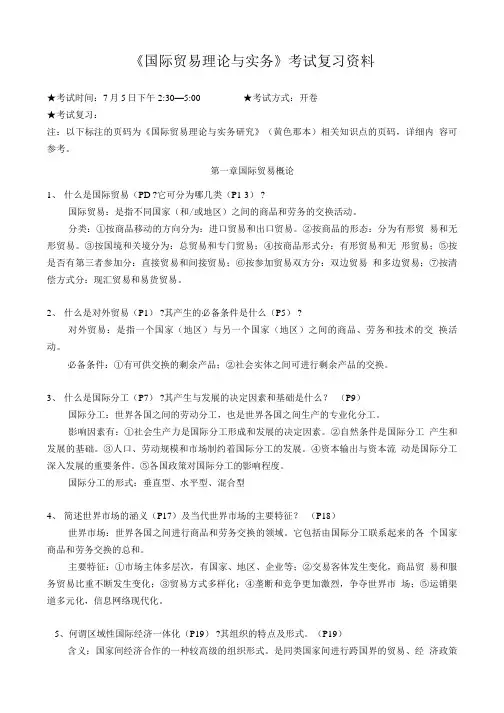
《国际贸易理论与实务》考试复习资料★考试时间:7月5日下午2:30—5:00 ★考试方式:开卷★考试复习:注:以下标注的页码为《国际贸易理论与实务研究》(黄色那本)相关知识点的页码,详细内容可参考。
第一章国际贸易概论1、什么是国际贸易(PD ?它可分为哪几类(P1-3) ?国际贸易:是指不同国家(和/或地区)之间的商品和劳务的交换活动。
分类:①按商品移动的方向分为:进口贸易和出口贸易。
②按商品的形态:分为有形贸易和无形贸易。
③按国境和关境分为:总贸易和专门贸易;④按商品形式分:有形贸易和无形贸易;⑤按是否有第三者参加分:直接贸易和间接贸易;⑥按参加贸易双方分:双边贸易和多边贸易;⑦按清偿方式分:现汇贸易和易货贸易。
2、什么是对外贸易(P1) ?其产生的必备条件是什么(P5) ?对外贸易:是指一个国家(地区)与另一个国家(地区)之间的商品、劳务和技术的交换活动。
必备条件:①有可供交换的剩余产品;②社会实体之间可进行剩余产品的交换。
3、什么是国际分工(P7) ?其产生与发展的决定因素和基础是什么?(P9)国际分工:世界各国之间的劳动分工,也是世界各国之间生产的专业化分工。
影响因素有:①社会生产力是国际分工形成和发展的决定因素。
②自然条件是国际分工产生和发展的基础。
③人口、劳动规模和市场制约着国际分工的发展。
④资本输出与资本流动是国际分工深入发展的重要条件。
⑤各国政策对国际分工的影响程度。
国际分工的形式:垂直型、水平型、混合型4、简述世界市场的涵义(P17)及当代世界市场的主要特征?(P18)世界市场:世界各国之间进行商品和劳务交换的领域。
它包括由国际分工联系起来的各个国家商品和劳务交换的总和。
主要特征:①市场主体多层次,有国家、地区、企业等;②交易客体发生变化,商品贸易和服务贸易比重不断发生变化;③贸易方式多样化;④垄断和竞争更加激烈,争夺世界市场;⑤运销渠道多元化,信息网络现代化。
5、何谓区域性国际经济一体化(P19) ?其组织的特点及形式。
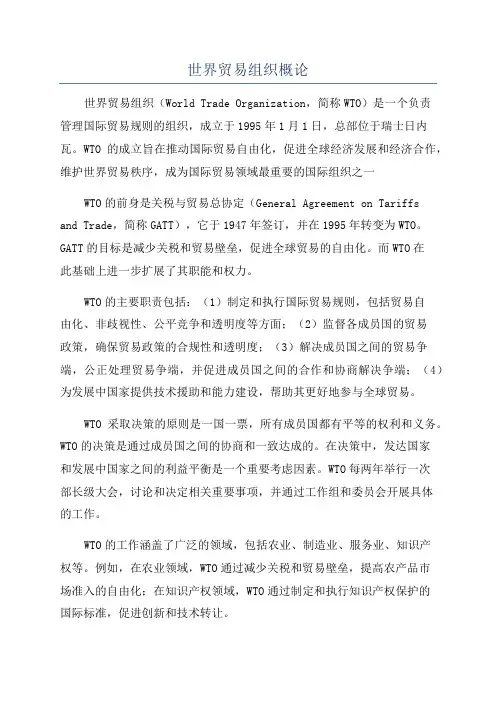
世界贸易组织概论世界贸易组织(World Trade Organization,简称WTO)是一个负责管理国际贸易规则的组织,成立于1995年1月1日,总部位于瑞士日内瓦。
WTO的成立旨在推动国际贸易自由化,促进全球经济发展和经济合作,维护世界贸易秩序,成为国际贸易领域最重要的国际组织之一WTO的前身是关税与贸易总协定(General Agreement on Tariffs and Trade,简称GATT),它于1947年签订,并在1995年转变为WTO。
GATT的目标是减少关税和贸易壁垒,促进全球贸易的自由化。
而WTO在此基础上进一步扩展了其职能和权力。
WTO的主要职责包括:(1)制定和执行国际贸易规则,包括贸易自由化、非歧视性、公平竞争和透明度等方面;(2)监督各成员国的贸易政策,确保贸易政策的合规性和透明度;(3)解决成员国之间的贸易争端,公正处理贸易争端,并促进成员国之间的合作和协商解决争端;(4)为发展中国家提供技术援助和能力建设,帮助其更好地参与全球贸易。
WTO采取决策的原则是一国一票,所有成员国都有平等的权利和义务。
WTO的决策是通过成员国之间的协商和一致达成的。
在决策中,发达国家和发展中国家之间的利益平衡是一个重要考虑因素。
WTO每两年举行一次部长级大会,讨论和决定相关重要事项,并通过工作组和委员会开展具体的工作。
WTO的工作涵盖了广泛的领域,包括农业、制造业、服务业、知识产权等。
例如,在农业领域,WTO通过减少关税和贸易壁垒,提高农产品市场准入的自由化;在知识产权领域,WTO通过制定和执行知识产权保护的国际标准,促进创新和技术转让。
然而,WTO也面临一些挑战和争议。
一方面,由于成员国的利益差异和发展水平不平衡,成员国之间的贸易争端日益增多,解决争端的程序和机制也面临压力。
另一方面,一些非政府组织和发展中国家批评WTO在一些问题上偏向发达国家,对发展中国家不够关注。
此外,全球贸易保护主义的抬头也对WTO的工作产生了影响。
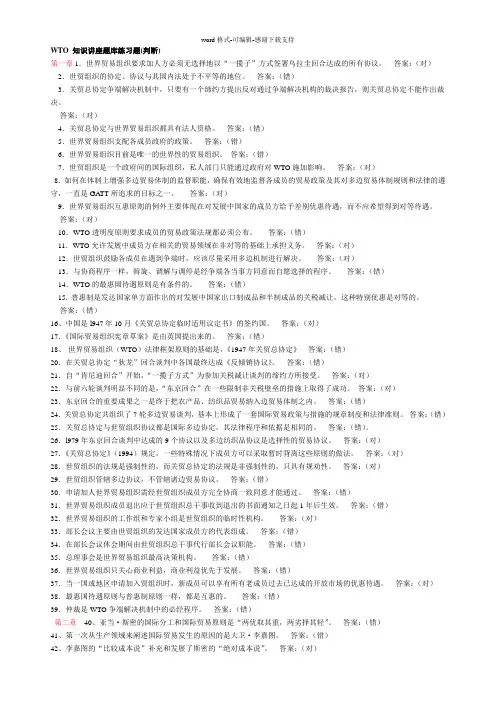
WTO 知识讲座题库练习题(判断)第一章1.世界贸易组织要求加人方必须无选择地以“一揽子”方式签署乌拉圭回合达成的所有协议。
答案:(对)2.世贸组织的协定、协议与其国内法处于不平等的地位。
答案:(错)3.关贸总协定争端解决机制中,只要有一个缔约方提出反对通过争端解决机构的裁决报告,则关贸总协定不能作出裁决。
答案:(对)4.关贸总协定与世界贸易组织都具有法人资格。
答案:(错)5.世界贸易组织支配各成员政府的政策。
答案:(错)6.世界贸易组织目前是唯一的世界性的贸易组织。
答案:(错)7.世贸组织是一个政府间的国际组织,私人部门只能通过政府对WTO施加影响。
答案:(对)8.如何在体制上增强多边贸易体制的监督职能,确保有效地监督各成员的贸易政策及其对多边贸易体制规则和法律的遵守,一直是GATT所追求的目标之一。
答案:(对)9.世界贸易组织互惠原则的例外主要体现在对发展中国家的成员方给予差别优惠待遇,而不应希望得到对等待遇。
答案:(对)10.WTO透明度原则要求成员的贸易政策法规都必须公布。
答案:(错)11.WTO允许发展中成员方在相关的贸易领域在非对等的基础上承担义务。
答案:(对)12.世贸组织鼓励各成员在遇到争端时,应该尽量采用多边机制进行解决。
答案:(对)13.与协商程序一样,斡旋、调解与调停是经争端各当事方同意而自愿选择的程序。
答案:(错)14.WTO的最惠国待遇原则是有条件的。
答案:(错)15. 普惠制是发达国家单方面作出的对发展中国家出口制成品和半制成品的关税减让,这种特别优惠是对等的。
答案:(错)16、中国是l947年10月《关贸总协定临时适用议定书》的签约国。
答案:(对)17.《国际贸易组织宪章草案》是由英国提出来的。
答案:(错)18、世界贸易组织(WTO)法律框架原则的基础是,《1947年关贸总协定》答案:(错)20.在关贸总协定“狄龙”回合谈判中各国最终达成《反倾销协议》。
答案:(错)21.自“肯尼迪回合”开始,“一揽子方式”为参加关税减让谈判的缔约方所接受。
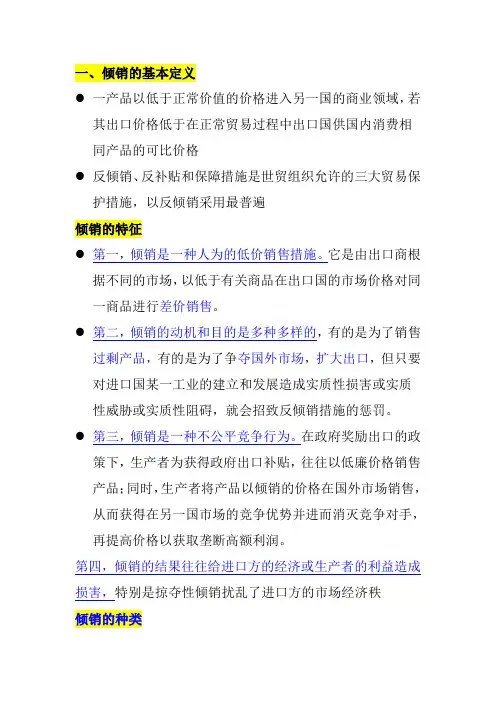
一、倾销的基本定义●一产品以低于正常价值的价格进入另一国的商业领域,若其出口价格低于在正常贸易过程中出口国供国内消费相同产品的可比价格●反倾销、反补贴和保障措施是世贸组织允许的三大贸易保护措施,以反倾销采用最普遍倾销的特征●第一,倾销是一种人为的低价销售措施。
它是由出口商根据不同的市场,以低于有关商品在出口国的市场价格对同一商品进行差价销售。
●第二,倾销的动机和目的是多种多样的,有的是为了销售过剩产品,有的是为了争夺国外市场,扩大出口,但只要对进口国某一工业的建立和发展造成实质性损害或实质性威胁或实质性阻碍,就会招致反倾销措施的惩罚。
●第三,倾销是一种不公平竞争行为。
在政府奖励出口的政策下,生产者为获得政府出口补贴,往往以低廉价格销售产品;同时,生产者将产品以倾销的价格在国外市场销售,从而获得在另一国市场的竞争优势并进而消灭竞争对手,再提高价格以获取垄断高额利润。
第四,倾销的结果往往给进口方的经济或生产者的利益造成损害,特别是掠夺性倾销扰乱了进口方的市场经济秩倾销的种类1、突发性倾销(Sporadic dumping),又称短期倾销(Short-run dumping),指某一商品的生产商为防止商品的大量积压危及国内的价格结构,在短期内向海外市场大量地低价抛售该商品。
这种类型的倾销对进口国工业的“损害”是暂时的,而进口国消费者却可以从中获取低价消费的好处,因而是无可厚非的2、间歇性倾销(Intermittent dumping),又称掠夺性倾销,指某一商品的生产商为了在某一海外市场上取得垄断地位而以低于边际成本的价格向该市场抛售商品,待将竞争对手驱逐出该市场后再实行垄断高价。
这种类型的倾销具有掠夺性意图,其对进口国工业的“损害”超过了进口国消费者获得的好处,因而应受到反倾销法的抵制。
3、持续性倾销(Persistent dumping),又称长期倾销(Long-run dumping)指某一商品的生产商一方面为了实现规模经济效益而大规模地进行生产,另一方面为了维持国内价格结构而将其中一部分商品长期地低价向海外市场销售。
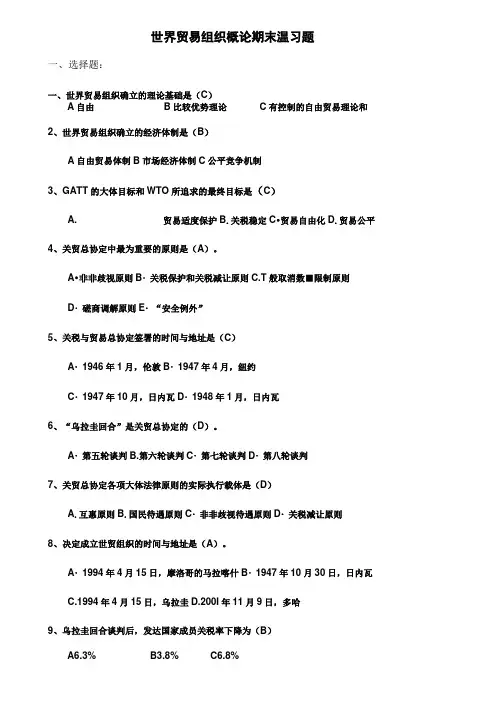
A自由贸易理B比较优势理论C有控制的自由贸易理论和世界贸易组织概论期末温习题一、选择题:一、世界贸易组织确立的理论基础是(C)2、世界贸易组织确立的经济体制是(B)A自由贸易体制B市场经济体制C公平竞争机制3、GATT的大体目标和WTO所追求的最终目标是(C)A. 贸易适度保护B.关税稳定C•贸易自由化D.贸易公平4、关贸总协定中最为重要的原则是(A)。
A•非非歧视原则B・关税保护和关税减让原则C.T般取消数■限制原则D・磋商调解原则E・“安全例外”5、关税与贸易总协定签署的时间与地址是(C)A・1946年1月,伦敦B・1947年4月,纽约C・1947年10月,日内瓦D・1948年1月,日内瓦6、“乌拉圭回合”是关贸总协定的(D)。
A・第五轮谈判B.第六轮谈判C・第七轮谈判D・第八轮谈判7、关贸总协定各项大体法律原则的实际执行载体是(D)A.互惠原则B.国民待遇原则C・非非歧视待遇原则D・关税减让原则8、决定成立世贸组织的时间与地址是(A)。
A・1994年4月15日,摩洛哥的马拉喀什B・1947年10月30日,日内瓦C.1994年4月15日,乌拉圭D.200I年11月9日,多哈9、乌拉圭回合谈判后,发达国家成员关税率下降为(B)A6.3% B3.8% C6.8%10、世界贸易组织的常设机构是(A)A总理事会B专门贸易理事会C秘书处及总干事1一、关贸总协定1948年开创缔约方有(B)。
A.22个B.23个C・24个D・25个1二、世界贸易组织的最高权利机构是(A)。
A.部长会议B・缔约方全部大会C・总理事会D.理事会13、保护世界经济运行的三大支柱(D)。
AWTO、世界银行和联合国贸易和发展会议BIMF、世界银行和联合国贸易和发展会议CWTO、世界卫生组织和国际货币基金组织DWTO、国际货币基金组织和世界银行14、在关贸总协定(C)中正式将给予发展中国家的优惠待遇纳入其具体条款中。
A.第三轮多边贸易谈判B.第四轮多边贸易谈判C・“肯尼迪回合”谈判D.“狄龙”回合谈判15、在关贸总协定(C)中第一次涉及非关税办法的谈判。
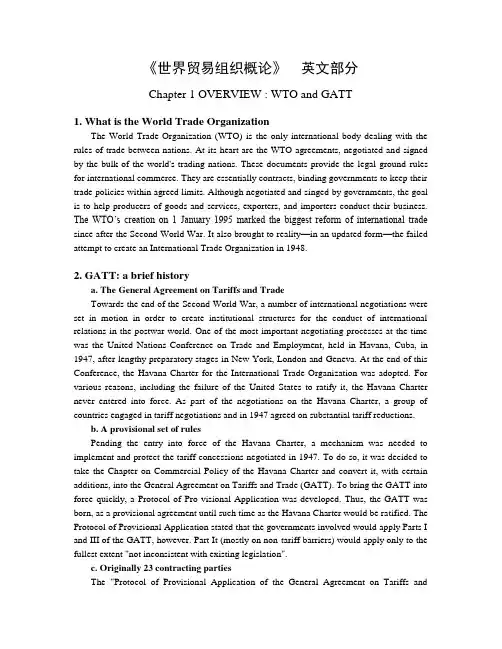
《世界贸易组织概论》英文部分Chapter 1 OVERVIEW : WTO and GATT1. What is the World Trade OrganizationThe World Trade Organization (WTO) is the only international body dealing with the rules of trade between nations. At its heart are the WTO agreements, negotiated and signed by the bulk of the world's trading nations. These documents provide the legal ground-rules for international commerce. They are essentially contracts, binding governments to keep their trade policies within agreed limits. Although negotiated and singed by governments, the goal is to help producers of goods and services, exporters, and importers conduct their business. The WTO’s creation on 1 January 1995 marked the biggest reform of international trade since after the Second World War. It also brought to reality—in an updated form—the failed attempt to create an International Trade Organization in 1948.2. GATT: a brief historya. The General Agreement on Tariffs and TradeTowards the end of the Second World War, a number of international negotiations were set in motion in order to create institutional structures for the conduct of international relations in the postwar world. One of the most important negotiating processes at the time was the United Nations Conference on Trade and Employment, held in Havana, Cuba, in 1947, after lengthy preparatory stages in New York, London and Geneva. At the end of this Conference, the Havana Charter for the International Trade Organization was adopted. For various reasons, including the failure of the United States to ratify it, the Havana Charter never entered into force. As part of the negotiations on the Havana Charter, a group of countries engaged in tariff negotiations and in 1947 agreed on substantial tariff reductions.b. A provisional set of rulesPending the entry into force of the Havana Charter, a mechanism was needed to implement and protect the tariff concessions negotiated in 1947. To do so, it was decided to take the Chapter on Commercial Policy of the Havana Charter and convert it, with certain additions, into the General Agreement on Tariffs and Trade (GATT). To bring the GATT into force quickly, a Protocol of Pro-visional Application was developed. Thus, the GATT was born, as a provisional agreement until such time as the Havana Charter would be ratified. The Protocol of Provisional Application stated that the governments involved would apply Parts I and III of the GATT, however. Part It (mostly on non-tariff barriers) would apply only to the fullest extent "not inconsistent with existing legislation".c. Originally 23 contracting partiesThe "Protocol of Provisional Application of the General Agreement on Tariffs andTrade" was signed by 23 countries. These original "Contracting Parties" were Australia, Belgium, Brazil, Burma, Canada, Ceylon, Chile, China, Cuba, the Czechoslovak Republic, France, India, Lebanon, Luxembourg, Netherlands, New Zealand, Norway, Pakistan, Southern Rhodesia, Syria, South Africa, the United Kingdom, and the United States of America.d. Entered into force: 1 January 1948The Protocol of Provisional Application entered into force on 1 January 1948.e. Terminated on 31 December 19953. Eight "rounds" of multilateral trade negotiationsThroughout its 48-year history, the GATT provided the structure for a global process of steady trade liberalization through eight "rounds" of multilateral trade negotiations sponsored by its Contracting Parties, covering progressively larger volumes of international trade. This process witnessed the initial years of the Cold War, the emergence to independence of many developing countries, the creation of the European Communities, the rise of new and important trading countries, the transition of many countries to market economies, the increasing globalization of the world economy and the consolidation of the multilateral trading system.4. WTO—international organization embodied in the results of the Uruguay RoundIn light of the entry into force of the Marrakesh Agreement establishing the World Trade Organization as of 1 January 1995 and its ratification by almost all GATT Contracting Parties, those parties decided to terminate the GATT 1947 as of 31 December 1995. The substance of GATT rules lives on since they are incorporated, with certain understandings, in the Marrakesh Agreement as GATT 1994.a. International organization embodied in the results of the Uruguay RoundThe Marrakesh Agreement, establishing the World Trade Organization, is included in the Final Act Embodying the Results of the Uruguay Round of Multilateral Trade Negotiations, concluded on 15 December 1993 and signed at Marrakesh Ministerial Meeting, on 15 April 1994. It constitutes the principal result of the "Uruguay Round" and incorporates, in its annexes, the multilateral agreements on trade in goods, including the "General Agreement on Tariffs and Trade", the "General Agreement on Trade in Services", the "Agreement on Trade-Related Aspects of Intellectual Property Rights", the " Understanding on Rules and Procedures Governing the Settlement of Disputes", the "Trade Policy Review Mechanism", and, for those countries having accepted them, the plurilateral trade agreements.b. Membership—139 countries and regionsAfter a period of intensive activity, and a vigorous debate on international trade policy inthe capitals of many countries participating in the negotiations of the Uruguay Round, the Marrakesh Agreement was ratified by a large number of countries, including the main trading nations, in time for its entry into force on 1 January 1995.By August 2000, one hundred and thirty-nine countries and regions had accepted and ratified the Marrakesh Agreement, and 28 more countries and regions were in the process of acceding to the World Trade Organization. The aim of the WTO is—as clearly indicated in its name—to be universal.c. The secretariat: around 500 staff, headed by a Director-General, based inGenevaProvision is made, in Article VI of the WTO Agreement, for the establishment of a Secretariat and the appointment of its Director-General. It was agreed by ministers that the GATT Secretariat would become the Secretariat of the WTO. At present it has approximately five hundred staff members. The WTO Secretariat is based in Geneva, Switzerland, at the Centre William Rappard.d. Current Director-General: Michael Moore (from New Zealand)5. WTO vs GATT: main differencesa. NatureThe GATT was a set of rules, with no institutional foundation,applied on a provisional basis. The WTO is a permanent institution with a permanent framework and its own secretariat.b. ScopeThe GATT rules applied to trade in goods. The WTO Agreement covers trade in goods, trade in services and trade-related aspects of intellectual property rights.c. ApproachWhile the GATT was a multilateral instrument, a series of new agreements were adopted during the Tokyo Round on a plurilateral—that is, selective—basis, causing a fragmentation of the multilateral trading system. The WTO has been adopted, and accepted by its Members, as a single undertaking: the Agreements which constitute the WTO are all multilateral, and therefore involve commitments for the entire membership of the organization.d. Dispute settlementThe WTO dispute settlement system has specific time limits and is therefore faster than the GATT system; it operates more automatically, thus ensuring less blockages than in the old GATT; and it has a permanent appellate body to review findings by disputs settlement panels. There are also more detailed rules on the process of the implementation of findings.6. WTO: the main objectivesa. To raise standards of livingRelations among Members of the WTO in the field of trade and economic endeavour should be conducted with a view to raising the standards of living of their populations,b. To ensure full employment to ensure full employment of their economies,c. Growing volume of real income and effective demand to promote the steadygrowth of real incomes and effective demand in their markets,d. Expanding the production of and trade in goods & servicesto expand the production of and trade in goods and services,e. Sustainable development and environmental protection while allowing for the optimal use of the world) s reserves in accordance with the objective of sustainable development, and protecting and Preserving the environment, andf. Developing countriesin a manner consistent with the respective needs and concerns of Members at different levels of development.7. WTO: functionsThe World Trade Organization is the institutional framework of the multilateral trading systerm. The main functions of WTO are as follows:a. Implementation, administration and operation of the covered agreementsThe WTO facilitates the implementation, administration and operation of the WTO Agreement and the Multilateral Trade Agreements, and furthers their objectives. It also provides the framework, for those of its Members that have accepted them, for the implementation, administration and operation of the Plurilateral Trade Agreements.b. Forum for negotiationsThe WTO provides the forum for negotiations on multilateral trade relations in matters covered by its various agreements. It may also, on decision by the Ministerial Conference, provide a forum for further negotiations, and a framework for the implementation of their results, on other issues arising in the multilateral trade relations among its Members.c. Dispute settlementThe WTO administers the integrated dispute settlement system, which is a central element in providing security and predictability to the multilateral trading system, serving to preserve the rights and obligations of the Members of the WTO.d. Review of national trade policiesThe WTO administers the Trade Policy Review Mechanism, which is designed to contribute to greater transparency and understanding of the trade policies and practices of WTO Members, to their improved adherence to the rules, disciplines and commitments of the multilateral trading system, and hence to the smoother functioning of the system.e. Coherence in global economic policy-makingA Ministerial Declaration adopted at the Marrakesh Ministerial Meeting recognizes the role of trade liberalization in achieving greater coherence in global economic policy-making. For this purpose, the WTO cooperates, as appropriate, with the International Monetary Fund, the World Bank, the United Nations Conference on Trade and Development and other world institutions.8. WTO: structurea. Ministerial ConferenceThe Ministerial Conference is the supreme body of the WTO, composed of representatives of all Members, with the authority to carry out the functions of the WTO, take the actions necessary to this effect, and take decisions on matters under any of the Multilateral Trade Agreements if so requested by a Member. The Ministerial Conference is to meet at least once every two years. The first WTO Ministerial Conference was held in Singapore in December 1996 and the second in Geneva in May 1998. The Third took place in Seattle, U.S.A. from 30th November to 3rd December 1999.b. General CouncilThe day to day business of the WTO is conducted by the General Council, also composed of representatives of all WTO Members, which meets on a regular basis (normally once every two months).The General Council acts on behalf of the Ministerial Conference in the periods between its meetings, and reports directly to it.(a) Dispute Settlement BodyThe General Council convenes also as the Dispute Settlement Body (DSB), which has its own Chairman and its own rules of procedure, to discharge the functions assigned to the DSB under the Dispute Settlement Understanding.(b) Trade Policy Review BodyThe General Council meets also as Trade Policy Review Body, which again has its own Chairman and rules of procedure, to carry out the review of Members' trade policies and practices, as provided for in the Trade Policy Review Mechanism.c. CouncilsThree sectoral councils have been established for goods, services and TRIPs matters, respectively. These Councils, operating under the general guidance of the General Council, carry out the responsibilities assigned to them by their respective agreements and by the General Council, they meet as necessary to carry out their functions, and they are open to representatives of all WTO Members. They may also establish subsidiary bodies, such as committees and working parties.(a) Council for Trade in GoodsThe Council for Trade in Goods oversees the functioning of the multilateral agreementson trade in goods. These include the General Agreement on Tariffs and Trade (GATT) and related Understandings, and twelve other agreements, as contained in Annex 1A to the WTO Agreement.(b) Council for Trade in ServicesThe Council for Trade in Services oversees the functioning of the General Agreement on Trade in Services (GATS).(c) Council for TRIPsThe Council for TRIPs oversees the functioning of the Agreement on Trade-Related Aspects of Intellectual Property Rights (TRIPs Agreement).d. Committees and other subsidiary bodiesThree main committees are established by the WTO Agreement: the Committee on Trade and Development, the Committee on Balance of Payments Restrictions, and the Committee on Budget, Finance and Administration. Membership of these committees is also open to all Members of the WTO. The General Council has established two other committees reporting to it: the committee on Trade and Environment and the Committee on Regional Trade Agreements.e. Decision-makingThe WTO continues the practice of decision-making by consensus followed under the GATT 1947. Consensus is defined as the situation where no Member, present at a meeting where a decision is taken, formally objects to the proposed decision. However, it is recognized that there may be situations where a consensus cannot be reached, in which case the matter may be decided by voting. Voting rules are set out in the WTO Agreement.Questions for Discussion and Reflection:1. What is the World Trade Organization?2. At what background was GATT born?3. What do you know about the eight rounds of multilateral trade negotiations?4. What are the main differences between GATT and WTO?5. What are WTO' s main objectives?6. Explain WTO' s functions.Chapter 2 WTO’ s Basic Principles1. Trade without discriminationThe basic principles of the multilateral trading system, as embodied in the WTO Agreement, derive mostly from the principles that constituted the foundations of the GATT. Trade without discrimination is one of these basic principles, guaranteed through the operation of various clauses included in the multilateral agreements on trade in goods, in the GATS, and in the TRIPs Agreement.2. Most-favoured-nation treatment (MFN)The most-favoured-nation clause has been the pillar of the system since the inception of the GATT in 1947. The Contracting Parties to the GATT 1947 were bound to grant to the products of other contracting parties treatment no less favourable than that accorded to products of any other country. Members of the WTO have entered into similar commitments, under the GATT 1994 (Article I ) for trade in goods, under the GATS (Article II ) in relation to treatment of service suppliers and trade in services, and under the TRIPs Agreement (Article 4) in regard to the protection of intellectual property.3. National Treatment (NT)The national treatment principle condemns discrimiation between foreign and national goods or services and service suppliers or between foreign and national holders of intellectual property rights.GATT 1994 and the TRIPS Agreement provide for national treatment as one of the main commitments of WTO Members. Imported goods, once duties have been paid, must be given the same treatment as like domestic products in relation to any charges, taxes, or administrative or other regulations (GATT Article 3). With regard to the protection of intellectual property rights, and subject to exceptions in existing international conventions. Members of WTO are committed to grant to nationals or other Members treatment no less favourable than that accorded to their own nationals (Article III ).GATS, however, due to the special nature of trade in services, deals with national treatment under its Part III, Specific Commitments, (Article XV II ), where national treatment becomes a negotiated concession and may be subject to conditions or qualifications that Members have inscribed in their schedules on specific commitments in trade in services.4. TransparencyProvisions on notification requirements and the Trade Policy Review MecHanism are set out in the WTO Agreement and its Annexes, with the objective of guaranteeing the fullest transparency possible in the trade policies of its Members in goods, services and the protection of intellectual property rights. Article X of GATT 1994 deals with the publicationand administration of trade regulations; Article III of GATS sets out provisions on transparency as one of the general obligations and disciplines under that agreement; and Article 3 establishes transparency rules for the TRIPs Agreement.5. Predictable and growing access to marketsPredictable and growing access to markets for goods and services is an essential principle of the WTO. This principle is fulfilled through various provisions so as to guarantee security, predictability and continued liberalization of trade.6. Binding of tariffsIn the case of goods, a basic GATT postulate is that tariffs should normally be the only instrument used to protect domestic industry. Furthermore, tariffs should be predictable and stable.Security and predictability in trade in goods are achieved through the commitments embodied in the "binding of tariffs". A "bound" tariff is a tariff in respect of which there is a legal commitment not to raise it beyond the bound level. The binding of a tariff at a level higher than the tariff actually applied is considered as a legitimate concession. In this case, the concession is the binding itself, that is , the commitment not to raise the tariff beyond that level. The developed countries have normally bound their tariffs at the applied levels. By contrast, and consistently with open market policies, developing countries have adopted commitments on "ceiling bindings", that is , bindings at levels higher than the applied rates. This has allowed developing countries to substantially increase their bound commitments, thus underpinning their open markets policies, while keeping a certain margin for protection in case of need.7. Tariff negotiations: progressive reduction in protectionIn the past, tariff negotiations were launched periodically under the auspices of the GATT. These negotiations served to reduce progressively the level of tariff protection in many countries now Members of the WTO. Tariff negotiations will remain important in the future, particularly in relation to agricultural products, where all non-tariff barriers have been eliminated and substituted by tariffs, in many cases at very high levels.8. Prohibition of quantitative restrictionsAs a general rule, quantitative restrictions are prohibited under the GATT 1994. However, in some cases, such as safeguard action, quantitative restrictions can be introduced under strictly defined criteia.9. Safeguards: emergency import measuresA safeguard measure is an import restriction which can be adopted in emergency circumstances, when imports have increased in such quantities and conditions that they are the cause of serious injury or threat of such injury to a domestic industry producing a like or directly competing product. An agreement on safeguards, setting out conditions and criteria for these actions, is one of the multilateral trade agreements. Measures affecting prices, that is tariffs, are preferable to quantitative restrictions. However, quantitative restrictions can be applied as safeguard measures in specific cases.10. Tariff renegotiations: compensationThe contractual nature of a bound tariff concession lies in the fact that the triff rate cannot be increased beyond the bound level. However, countries would not enter into this kind of commitment without the possibility of revision when the situation of a domestic industry so requires. The GATT 1994 allows for the possibility of renegotiations. A Member desiring to withdraw or modify tariff bindings has to renegotiate them with other interested Members and provide compensation, that is, substantially equivalent tariff concessions on other products.Questions for Discussion and Reflection:1. What does non-discrimination treatment mean?2. Please explain MFN and NT principles.3. Why should WTO member's trade policies be transparent?4. Why should quantitative restrictions be prohibited?5. What does "binding of tariffs" really mean?6. Why should safeguards be taken as one of the WTO principles?Chapter 3 WTO: Dispute Settlement1. The integrated dispute settlement systemThe integrated dispute settlement system is an important part of the multilateral trading system embodied in the WTO. It is based on Articles XX II and XXIII of the GATT 1994, and the rules and procedures further elaborated in the Understanding on Rules and Procedures Governing the Settlement of Disputes (DSU) contained in the WTO Agreement. The rules have evolved on the basis of past practice in GATT 1947.2. Coverage: goods, services and intellectual propertyThe dispute settlement system covers all the multilateral trade agreements, that is, it is applicable to trade in goods, trade in services, and intellectual property issues arising from the TRIPs Agreement. It is also applicable to disputes arising under the plurilateral Government Procurement Agreement. Some of these agreements have dispute settlement provisions that apply only to disputes arising under that specific agreement and that add to or change the rules of the DSU. The dispute settlement system is administered by the Dispute Settlement Body:3. Procedures: strict time-limitsThe dispute settlement process is initiated through a request for consultations made by one Member to another in respect of a specific issue. If consultations fail to resolve a dispute, a Member may ask the DSB to establish a panel, normally consisting of three independent trade experts, to rule on the issue. After hearing the parties, the panel issues a report to the DSB. For the panel, strict time-limits have been agreed so as to achieve the greatest efficiency possible under the system. A large degree of automaticity is involved in this process.4. Adoption of panel reports: the reverse consensusUnder GATT practice, the report of a panel was submitted to the GATT Contracting Parties for adotion. Since the Contracting Parties normally took decisions by consensus, any Party (including the losing Party) could block adoption of a panel report. While this did not occur frequently, it happened from time to time. An innovative formula has been agreed upon in the DSU, whereby a consensus in the negative is required in order not to adopt a panel report. This formula allows for a smoother functioning of the system.5. Appellate body reviewThe WTO dispute settlement mechanism gives the possibility of appeal to either party in a panel proceeding. However, any such appeal must be limited to issues of law covered in thepanel report and the legal interpretations developed by the panel. Appeals are heard by a standing Appellate Body consisting of seven members appointed by the DSB for four year terms. The report of the Appellate Body must be unconditionally accepted by the parties to the dispute, and the report is to be adopted by the DSB unless there is a negative consensus, that is a consensus against adoption.6. Non-compliance with recommendationsThe Dispute Settlement Body keeps under surveillance the implementation of adopted recommendations or rulings, and any outstanding issue remaining in its agenda until its resolution. Timelimits are also established for compliance with recommendations of panel reports. When a party is unable to implement those recommendations within a reasonable period of time, it is obliged to enter into negotiations with the complainant in order to determine mutually acceptable compensation. If these negotiations fail, the Dispute Settlement Body may authorize the complainant party to suspend concessions or obligations against the other party. Compensation and suspension of concessions are, however, interim solutions until such time when the recommendations of the DSB are implemented by the member concerned.Questions for Discussion and Reflection:1. What is dispute settlement mechanism?2. What is reverse consensus?3. Explain the dispute settlement procedures.4. What can be done if a member does not implement Dispute Settlement Body’srecommendations?Chapter 4 WTO: Trade Policy Review Mechanism1. IntroductionThe Trade Policy Review Mechanism (TPRM) was introduced into GATT in 1989 following the Mid-Term Review of the Uruguay Round. The mechanism was confirmed as an integral part of the WTO in Annex 3 of the Marrakesh Agreement establishing the World Trade Organization. Before 1995, trade policy reviews were restricted to trade in goods. In conformity with WTO rules, since 1 January 1995 reviews have also covered new areas like trade in services and intellectual property rights.2. ObjectivesThe purpose of the TPRM is to "contribute to improved adherence by all Members to rules, disciplines and commitments made under the Multilateral Trade Agreements and, where applicable, the Plurilateral Trade Agreements, and hence to the smoother functioning of the multilateral trading system, by achieving greater transparency in, and understanding of, the trade policies and practices of Members^. The review covers the full range of individual Members trade policies and practices and their impact on the functioning of the multilateral trading system. It is not confined to a consideration of the trade policies from the point of view of consistency with WTO rules. The purpose is to enable a collective appreciation and evaluation of these policies and practices. It is not meant to serve as a basis for enforcement of specific obligations or to impose new commitments.3. Trade policy reviewsThe TPRM seeks to achieve its objectives by conducting reviews, over time, of all WTO Members. Through such reviews, Members undertake the regular collective appreciation of the trade policies and practices of trading partners. Also examined is the impact on the multilateral trading system of such policies and practices.The reviews are set against the background of each country's wider economic and developmental needs, policies, objectives, and of its external economic environment.4. Scope of reviewsReviews in the TPRM seek to show the extent to which individual trading entities follow basic WTO principles. Those principles are as follows:—Transparency of trade policies;— Non-discrimination in treatment of trading partners;— Whether their policies contribute to trade liberalization;— The degree of stability and predictability in trade policies;— The pattern of protection and the extent to which tariffs only are used as measures of。

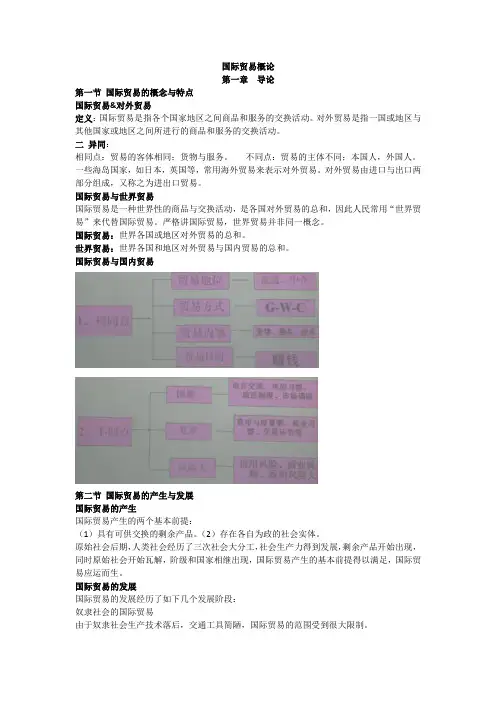
国际贸易概论第一章导论第一节国际贸易的概念与特点国际贸易&对外贸易定义:国际贸易是指各个国家地区之间商品和服务的交换活动。
对外贸易是指一国或地区与其他国家或地区之间所进行的商品和服务的交换活动。
二异同:相同点:贸易的客体相同;货物与服务。
不同点:贸易的主体不同;本国人,外国人。
一些海岛国家,如日本,英国等,常用海外贸易来表示对外贸易。
对外贸易由进口与出口两部分组成,又称之为进出口贸易。
国际贸易与世界贸易国际贸易是一种世界性的商品与交换活动,是各国对外贸易的总和,因此人民常用“世界贸易”来代替国际贸易。
严格讲国际贸易,世界贸易并非同一概念。
国际贸易:世界各国或地区对外贸易的总和。
世界贸易:世界各国和地区对外贸易与国内贸易的总和。
国际贸易与国内贸易第二节国际贸易的产生与发展国际贸易的产生国际贸易产生的两个基本前提:(1)具有可供交换的剩余产品。
(2)存在各自为政的社会实体。
原始社会后期,人类社会经历了三次社会大分工,社会生产力得到发展,剩余产品开始出现,同时原始社会开始瓦解,阶级和国家相继出现,国际贸易产生的基本前提得以满足,国际贸易应运而生。
国际贸易的发展国际贸易的发展经历了如下几个发展阶段:奴隶社会的国际贸易由于奴隶社会生产技术落后,交通工具简陋,国际贸易的范围受到很大限制。
贸易商品:奢侈品(如宝石,装饰品,各种织品和香料等)贸易地区:腓尼基(现在黎巴嫩境内),埃及,罗马,印度,中国封建社会的国际贸易由于交通运输工具,主要是船只的进步,国际贸易的范围进一步扩大。
贸易商品:奢侈品(如金银,丝绸,香料,宝石,象牙,瓷器,和少量的麻纺织品)贸易地区:封建社会早期:地中海东部,阿拉伯地区;公元11世纪以后:地中海,北海,波罗的海和黑海沿岸的一些城市,如威尼斯,鹿特丹等成为当时西方贸易中心。
资本主义的发展真正具有世界性质的国际贸易是在资本主义生产方式确立之后发展起来。
资本主义社会的国际贸易(1)资本主义原始积累时期的国际贸易。

wto概论期末考试题及答案一、单项选择题(每题2分,共20分)1. WTO的全称是什么?A. 世界贸易组织B. 世界旅游组织C. 世界贸易联盟D. 世界贸易论坛答案:A2. WTO的总部设在哪个国家?A. 美国B. 瑞士C. 法国D. 英国答案:B3. WTO的前身是哪个组织?A. 关贸总协定B. 国际货币基金组织C. 世界银行D. 联合国贸易和发展会议答案:A4. WTO的主要职能是什么?A. 促进全球贸易自由化B. 协调国际货币关系C. 提供国际援助D. 维护世界和平答案:A5. WTO的成员国数量是多少?A. 164个B. 192个C. 159个D. 189个答案:A6. WTO的决策机制是什么?A. 一国一票制B. 多数票制C. 双多数制D. 一票否决制答案:C7. WTO的争端解决机制是什么?A. 仲裁B. 调解C. 诉讼D. 专家组答案:D8. WTO的贸易政策审议机制是什么?A. 定期审议B. 随机审议C. 选择性审议D. 非正式审议答案:A9. WTO的“特殊和差别待遇”原则主要针对哪些国家?A. 发达国家B. 发展中国家C. 最不发达国家D. 所有成员国答案:B10. WTO的“最惠国待遇”原则要求成员国对所有其他成员国提供什么?A. 最低关税B. 最高关税C. 同等待遇D. 不同待遇答案:C二、多项选择题(每题3分,共15分)1. 下列哪些是WTO的主要协议?A. 关税及贸易总协定B. 服务贸易总协定C. 与贸易有关的知识产权协定D. 环境协议答案:A, B, C2. WTO成员国在贸易中不得采取哪些措施?A. 出口补贴B. 进口配额C. 出口限制D. 反倾销措施答案:B, C3. WTO的基本原则包括哪些?A. 非歧视原则B. 透明度原则C. 自由贸易原则D. 公平竞争原则答案:A, B, C4. WTO的争端解决程序包括哪些阶段?A. 磋商B. 专家组审理C. 申诉机构复审D. 执行和监督答案:A, B, C, D5. 下列哪些是WTO的主要功能?A. 制定和执行国际贸易规则B. 提供争端解决机制C. 监督成员国的贸易政策D. 提供技术援助和培训答案:A, B, C, D三、判断题(每题2分,共10分)1. WTO是一个国际组织,其成员国必须遵守其制定的规则。
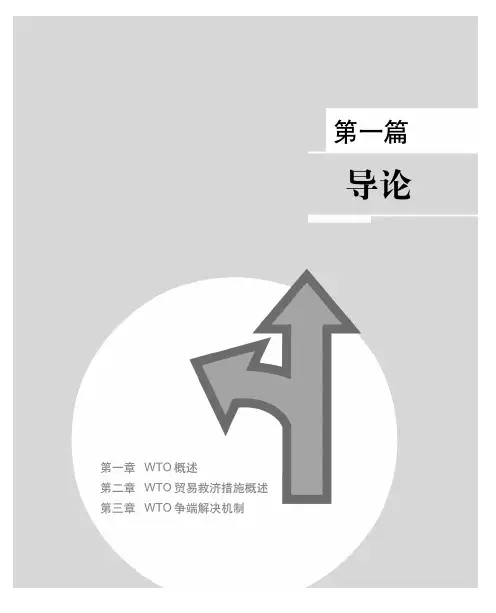
23第一章 WTO 概述重要概念世界贸易组织、关税与贸易总协定、贸易无歧视原则、最惠国待遇、国民待遇、贸易自由化原则、贸易可预见性原则、促进公平竞争原则、鼓励发展和经济改革原则、部长级会议、总理事会。
世界贸易组织(World Trade Organization ),简称世贸组织(WTO ),是一个独立于联合国的永久性国际组织,它负责管理世界贸易秩序。
世界贸易组织建立于1995年1月1日,其机构设在日内瓦,现有成员国149个(至2005年12月)。
第一节 WTO 的建立、基本原则和职能在WTO 正式运行之前,1947年关税与贸易总协定是协调、处理缔约方之间关税和贸易问题的主要多边协定。
20世纪90年代,世界贸易组织成立,取代1947年关贸总协定成为世界多边贸易体制的组织和法律基础。
本节将在介绍关贸总协定的基础上,分析WTO 的建立、基本原则和职能。
一、关税与贸易总协定(一)关税与贸易总协定的产生关税与贸易总协定(The General Agreement on Tariff and Trade ,简称GATT )是4调整各国关税与贸易关系的多边国际协定。
由于关税与贸易总协定特殊的签订背景,以及它多年运行的特点,使它成为带有制度性和组织性的多边贸易协定。
在第二次世界大战结束之前,美国和英国就建立战后国际经济新秩序而进行了一系列的双边和多边会谈。
它们认为,20世纪20年代中期以后,各国相继实行的以邻为壑的贸易政策,是导致20世纪30年代经济大危机的原因之一,第二次世界大战也与之有很大的关系。
1944年7月,英、美等44个国家召开“布雷顿森林”会议,讨论国际货币问题,并建立国际货币基金组织(IMF )和国际复兴开发银行(世界银行)。
1945年年底,美国政府为补充布雷顿森林会议决议而提出《扩大世界贸易和增加就业的建议》,该议案提出了建立新的国际贸易体制的原则,包括削减关税、消除贸易壁垒、取消数量限制和外汇管制措施,等等。
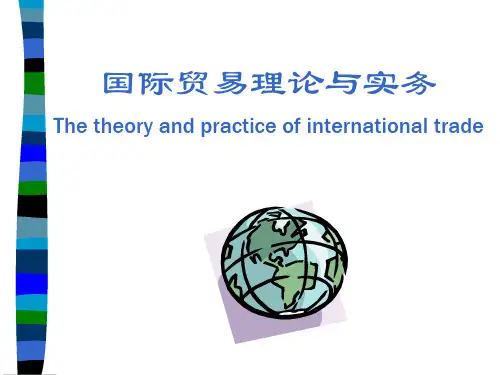
WTO概论世界贸易组织成立与1995年1月1日,机构设在日内瓦,现有成员150个。
中国于2001年12月11日加入,为第143个成员。
第一轮谈判:23个缔约方参加,除德国和日本,签订了关税与贸易总协定临时适用协议书。
第三轮谈判:台湾以中国的名义退出关贸总协定。
第四轮谈判:日本加入关贸总协定。
第六轮谈判:肯尼迪回合,增“贸易与发展部分”,明确提出非互惠原则。
第八轮谈判:大成了服务贸易总协定和与贸易有关的知识产权协定多哈部长会议中国加入。
WTO和GATT的区别:纺织品服装协议已到期;国际奶制品协议和国际牛肉协议已废止。
贸易无歧视原则:规定成员一方在实施某项优惠和限制措施时,不得对其他成员方实施歧视待遇。
最惠国待遇:WTO成员方在或将来给予其他成员方的优惠待遇不得低于该成员方给予任何第三方的优惠待遇,否则就构成差别待遇或歧视。
最惠国待遇与国民待遇的区别:贸易自由化原则:1.货物贸易自由化:消减关税;减少非关税壁垒。
2.服务贸易自由化。
3.提高市场准入水平。
促进公平竞争原则:通过对补贴,倾销等“不公平”贸易行为的制裁,来保证一个竞争性更强的多边贸易体制。
部长级会议:最高决策机构,至少两年举行一次部长级会议,所有成员方的代表都有资格参加会议,有权对多边贸易协议下的所有事项做出决定。
总理事会:是除部长级会议之外的WTO最高权力机构。
协商一致的决策机制:对国际会议和国际组织使用协商一致做为决策程序规则的借鉴,可以避免通过投票产生对立。
协商一致原则是对GATT表决制度的发展,体现了国家主权平等原则,适应当今世界经济贸易的发展需求,在WTO决策机制中发挥着十分重要的作用。
例外条款:对《建立WTO的协议》及多边贸易协定的修改;豁免义务;对《关于争端解决规则与程序的谅解》的修改;争端解决机构依照DSU做决定时,需以协商一致方式做出;对《建立WTO的协议》附件4诸边贸易协议的增加等。
第三方介入:其必须是WTO成员;其必须是争端焦点所指协议的当事方;此成员方必须对审理的重大事实享有实质性利益;此成员方必须向DSB发出通知,表明其实质性利益的存在。
世界贸易组织概论世界贸易组织(World Trade Organization,简称WTO)是一个全球性的国际组织,其任务是监管和促进国际贸易。
WTO的宗旨是通过促进贸易自由化和贸易规则的制定,建立一个公平、透明和可预测的国际贸易环境,以增加全球贸易和促进各国经济繁荣。
WTO成立于1995年,其前身是1947年成立的关税和贸易总协定(General Agreement on Tariffs and Trade,简称GATT)。
GATT面临的一个主要问题是其只覆盖了商品贸易,而忽视了服务贸易和知识产权等其他领域。
因此,在经历了多轮谈判和协商的基础上,GATT最终发展成为了WTO,以扩大贸易规则的范围和深度。
WTO的成员包括了全球大多数国家和地区,目前拥有164个成员国,涵盖了近98%的全球贸易。
每个成员国都有自己的贸易政策和利益,WTO 通过谈判和协商来平衡各国贸易政策的利益关系。
WTO的最高决策机构是部长级会议,成员国代表在此会议上商讨并决定贸易规则的制定和修改。
WTO的核心原则是最惠国待遇原则。
根据这一原则,一个国家对一个成员国的待遇必须适用于所有其他成员国。
这意味着一个国家不得歧视其他成员国的贸易,所有成员国在贸易上享有平等和公平的待遇。
此外,WTO的其他原则还包括国民待遇原则(国内和外国企业应享受相同的待遇)、透明度原则(贸易政策应透明,并运行在一个可预测的环境中)和贸易优惠原则(发展中国家享有特殊优惠)。
WTO的工作包括贸易谈判、贸易规则的监管和争端解决。
在贸易谈判方面,WTO致力于促进贸易自由化,减少关税和非关税壁垒,并推动服务贸易、农业和知识产权等领域的规则制定。
在贸易规则的监管方面,WTO通过定期审查成员国的贸易政策,确保其符合WTO的规则和义务。
WTO还提供了争端解决机制,成员国可以通过争端解决程序解决彼此之间的贸易争端。
然而,WTO也面临着一些挑战和批评。
一些发展中国家认为WTO的规则偏向发达国家,造成了不平等的贸易条件。